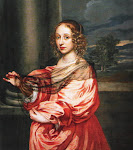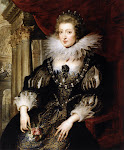This blog has now moved over to Wordpress.
Please join me at Weave a Garland for all future updates.
Many thanks :o)
Tuesday 5 May 2009
Monday 4 May 2009
Lilac in History
May is the month for lilacs.

Mine are coming into bloom right now. The lilac above grows outside my back door and I adore everything about this shrub. The season is short but intense. In fact, much about lilac seems to be intense from the tight clusters of perfect flowers, to the unforgettable scent, to the historical perspective.
Syringa vulgaris - the common lilac - was brought into Europe in the 16th century by traders and ambassadors to the Persian and Ottoman empires. It represented the secrecy of paradise in these exotic domains.
In Renaissance times it was thought that Pan's pipes were made from the hollow stems of the lilac bush as syringa comes from the word syrinx meaning tube.
The early 17th century gardens of England and France overflowed with lilac but as time passed and the plant came out of the privacy of royal and noble spaces and into public areas, it lost its original connection to that Eastern secret paradise.
It became common.
The Victorian language of flowers further damaged lilac's reputation by making it the indicator of death - coffins were routinely draped with white lilac boughs.
In England the profusion of tiny flowers, the magical colours and the heady scent all came to be associated with decadence and sexuality.

In France these qualities were embraced. Louis XIV adored lilac.
So did the Empress Josephine who had Redoute paint pictures of the plant for her.

Lilac - the symbol of 'ever-returning spring.'
~
Sunday 3 May 2009
Henri IV
Henri IV as written by Gédéon Tallemant des Réaux.

If this prince had been born King of France and had lived in peaceful times, it is probable that he would never have arrived at greatness; he would have been nothing more than a voluptuary.
Even in the most critical situations, he would leave all to follow some amour. After the battle of Coutras, instead of following up his advantage, he went off to dally with the Countess de Guiche, taking her the banners he had won that day, and, during the siege of Amiens, he ran after Gabrielle d'Estrées without troubling himself about the Cardinal of Austria, who was coming to relieve the town.

If Sebastian Zamet really poisoned Gabrielle, he rendered a great service to Henri IV, for that good prince was about to commit a great folly, being on the point of declaring that the Prince de Condé was a bastard. The Count de Soissons was a Cardinal, receiving 300,000 crowns a year as benefice; the Prince de Conti was married to a woman who was barren, the Marshal de Biron was to have married the daughter of d'Estrées.
This Madame d'Estrées was from La Bourdaisière, the race that has produced the greatest number of gay women to be found in all France; there were as many as twenty-five or twenty-six of them; some were nuns, some married women; all lived a life of gallantry. It happens, by an amusing chance, that the arms of La Bourdaisière contain a hand sowing vetches, which has earned them the nickname of a handful of vetches.
Madame d'Estrées had six daughters and two sons, one of whom is the Marshal, who is alive today; the six and this brother were called the seven deadly sins. Madame de Neufvic, a witty woman, made this epitaph on the death of Gabrielle.
I saw pass by my window
Six mortal living sins
Led by a Priest’s bastard.
They all sang together
A requiem for the seventh,
Who had passed away.
Henri IV had a most strange collection of mistresses; he was not a gadabout and he was always made a cuckold.
Madame de Verneuil one day called him Captain Good Will, but the next day she scolded him cruelly and remarked that it was a good thing he was King, as if he were not, nobody would endure him, and that he stank like carrion.
She was quite right, for when the late Queen (Marie de Medici) slept with him, she was terribly perfumed afterwards, although she used all sorts of scents which she had brought from her own country. I do not think that anyone approved of the conduct of Henri IV to his wife.

Madame de Verneuil was the daughter of M. D’Entragues, who married Marie Touchet, the daughter of a butcher of Orleans, who had been the mistress of Charles IX. Madame de Verneuil was very proud and showed no respect either to the King or Queen, speaking of the latter to the King as ‘your Fat Banker.’
He once asked her what she would have done if she had been at Neuilly when the Queen had nearly drowned.
‘I should have cried,’ she said, ‘the Queen drinks!’
The King broke with her at last, and she gave herself up to eating and drinking.She became immensely fat, and led a life like that of Sardanapolus (The character which Ctesias depicted or invented, an effeminate debauchee, sunk in luxury and sloth) or Vitellius (lazy and self-indulgent, fond of eating and drinking, and an obese glutton, eating banquets four times a day and feasting on rare foods he would send the Roman navy to procure.)
Her children were taken from her, and the daughters were brought up by the Daughters of France.
Gédéon Tallemant des Réaux
I'm fortunate enough to have Vol. 746 of 1000 of Love Tales from Tallemant.


Gédéon Tallemant des Réaux was born around 1619, the son of financier Pierre Tallemant and his second wife Marie de Rambouillet.
Tallemant's father was rich but mean and his son found life at home so restrictive that he proposed to his first cousin Elizabeth de Rambouillet. The marriage came about but consummation took two years because of the extreme youth of the bride yet Tallemant had chosen well. Marriage made him independent and free to enjoy the society of his mother's family, especially the celebrated Arthenice - Catherine de Vivonne, Marquise de Rambouillet.
Arthenice's famous Blue Salon introduced the bourgeois des Réaux to court society... against whom he sharpened his famous but simple, crude and sarcastic wit in a collection of writings known as the Historiettes.
The Love Tales from Tallemant draw fantastic pictures of the world of Henri IV and his contemporaries.
Labels:
Gédéon Tallemant des Réaux,
Henri IV
Saturday 2 May 2009
Subscribe to:
Posts (Atom)











